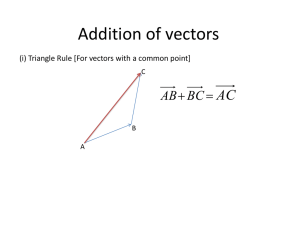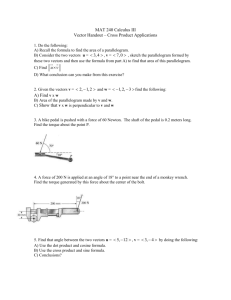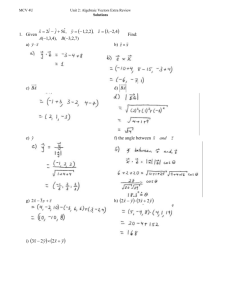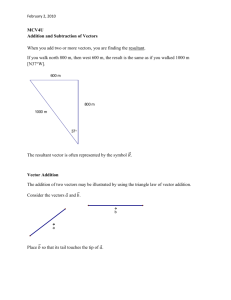2 – i
advertisement
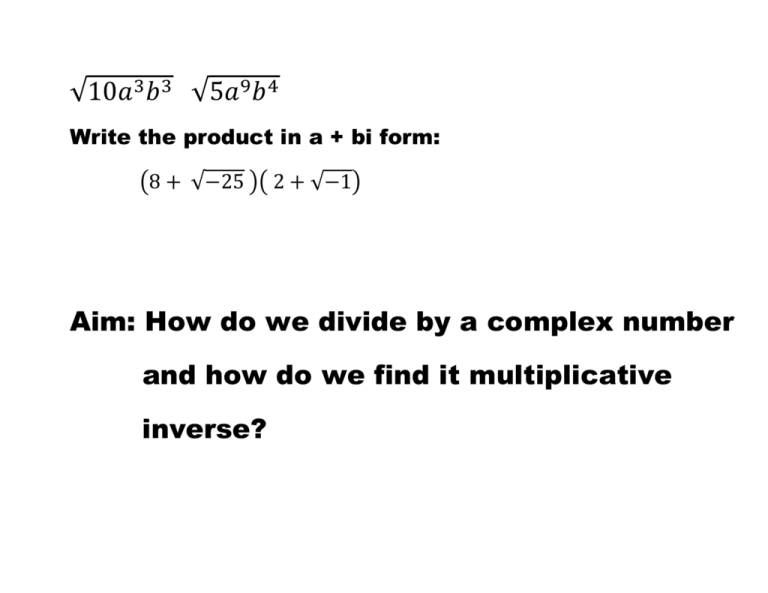
√10𝑎3 𝑏 3 √5𝑎9 𝑏 4 Write the product in a + bi form: (8 + √−25 )( 2 + √−1) Aim: How do we divide by a complex number and how do we find it multiplicative inverse? The multiplicative inverse of a + bi is 1 𝑎+𝑏𝑖 , a +bi ≠ 0. *You must rationalize the denominator. Practice: Find the multiplicative inverse and express in a + bi form: 1) 2 – i 2) 1 + 5i Divide: 3) 4) 5) 2 5𝑖 15𝑖 𝑖+2 2+5𝑖 3−𝑖 Two complex numbers are equal if and only if their real parts are equal and their imaginary parts are equal. a + bi = c + di iff a = c and bi = di b = d Determine the values of a, b, x, y for which the equation is true. 1) a + bi = 7 + 2i 2) a + bi = 12 + i – 3 3) a + √−16 = 16 + bi 4) 3x + 5yi = 15 – 20i 5) x + 6i +3 = 12 + yi 6) x – 3yi = 18i Aim: How do we represent addition and subtraction of complex numbers graphically? How do we find a vector’s magnitude and its absolute value? Do Now: Express in simplest form: 𝑖 6 + 𝑖 8 + −421 + 𝑖 43 Graphing Complex Numbers We represent complex numbers as vectors. A vector (ray) has magnitude (length) and direction. 2) Real Numbers x – axis Pure Imaginary y – axis called yi 3) x + yi = 2 + 5i is located the same way as (x,y) = (2,5) 4) origin = (0,0) = 0 + 0i We can express the sum of 2 complex numbers as a vector which is the diagonal of a parallelogram. The diagonal of a parallelogram is called the resultant. 1. 3 + 4 𝑖 2. 2 − 3𝑖 3. −4 + 2𝑖 4. 3 (𝑤ℎ𝑖𝑐ℎ 𝑖𝑠 𝑟𝑒𝑎𝑙𝑙𝑦 3 + 0𝑖 ) 5. 4𝑖 (𝑤ℎ𝑖𝑐ℎ 𝑖𝑠 𝑟𝑒𝑎𝑙𝑙𝑦 0 + 4𝑖) 1) Find the sum of 3 + 4𝑖 and −4 + 2𝑖. 2) Graph 3 + 4𝑖 3) Graph −4 + 2𝑖 How would you graph the sum? Steps: 1. Graph the two complex numbers as vectors. 2. Create a parallelogram using these two vectors as adjacent sides. 3. The answer to the addition is the vector forming the diagonal of the parallelogram (read from the origin). 4. This new vector is called the resultant vector. 2. 3. 4. 5. 6. Motivation #3: 1. Graph 3 + 4i 2. Graph -2 + 2i 3. Subtract 3 + 4i from -2 + 2i Subtraction is the process of adding the additive inverse. (-2 + 2i) - (3 + 4i) = (-2 + 2i) + (-3 - 4i) = (-5 - 2i) What do you think would be the steps used to graph the difference of 2 complex numbers? Steps: 1. Graph the two complex numbers as vectors. 2. Graph the additive inverse of the number being subtracted. 3. Create a parallelogram using the first number and the additive inverse. The answer is the vector forming the diagonal of the parallelogram. Example 1: Plot z = 8 + 6i on the complex plane, connect the graph of z to the origin (see graph below), then find | z | by appropriate use of the definition of the absolute value of a complex number. Example 2: Find the | z | by appropriate use of the Pythagorean Theorem when z = 2 - 3i. You can find the distance | z | by using the Pythagorean theorem. Consider the graph of 2 - 3i shown at the left. The horizontal side of the triangle has length | a |, the vertical side has length | b |, and the hypotenuse has length | z |. By applying the Pythagorean Theorem, you have, | z |2 = a2 + b2 . Notice: you can drop the absolute value symbols for a and b since | a |2 = a2 and 2 2 | b | = b . You must keep the absolute value symbol for z to insure that the final answer will be positive. Solving this equation for | z |, you have just derived the formula for the absolute value of a complex number: Mixed Practice: Show Graphically: 1) the vector difference (-3 - i) – (-2 +4i) 2) the vector sum (3 - 3i) + (4 + 4i) 3) the vector difference (-4 – i) – (2 + 4i) Example 3: If z = - 8 - 15i, find | z |.

